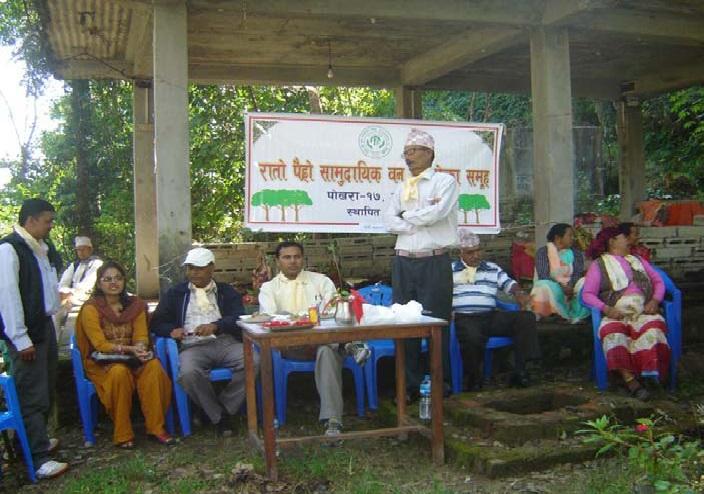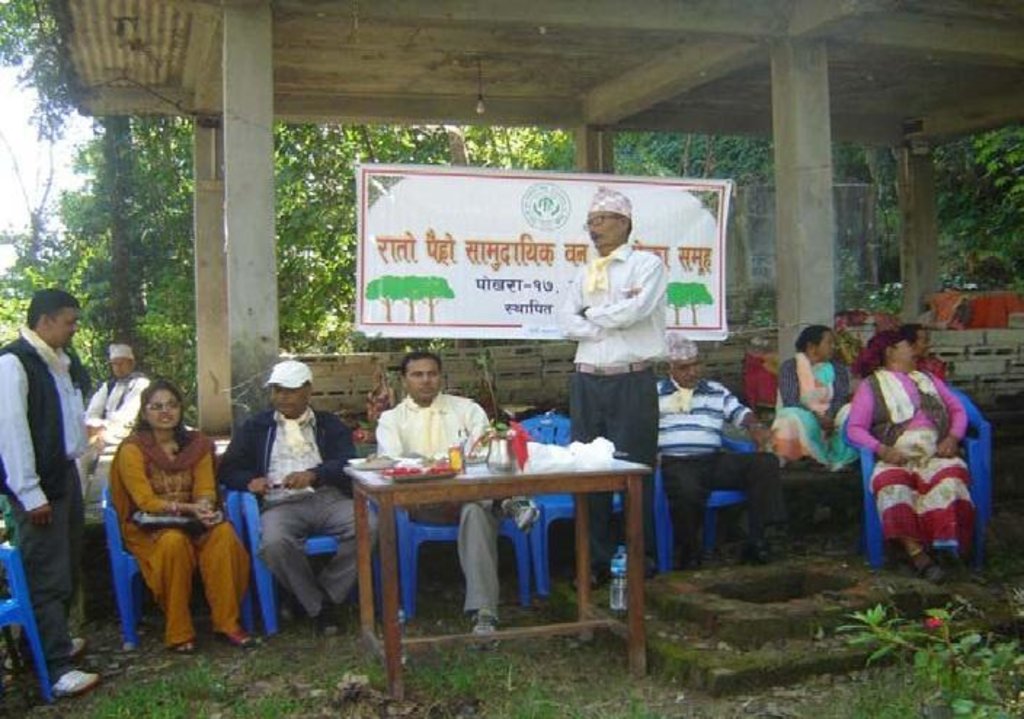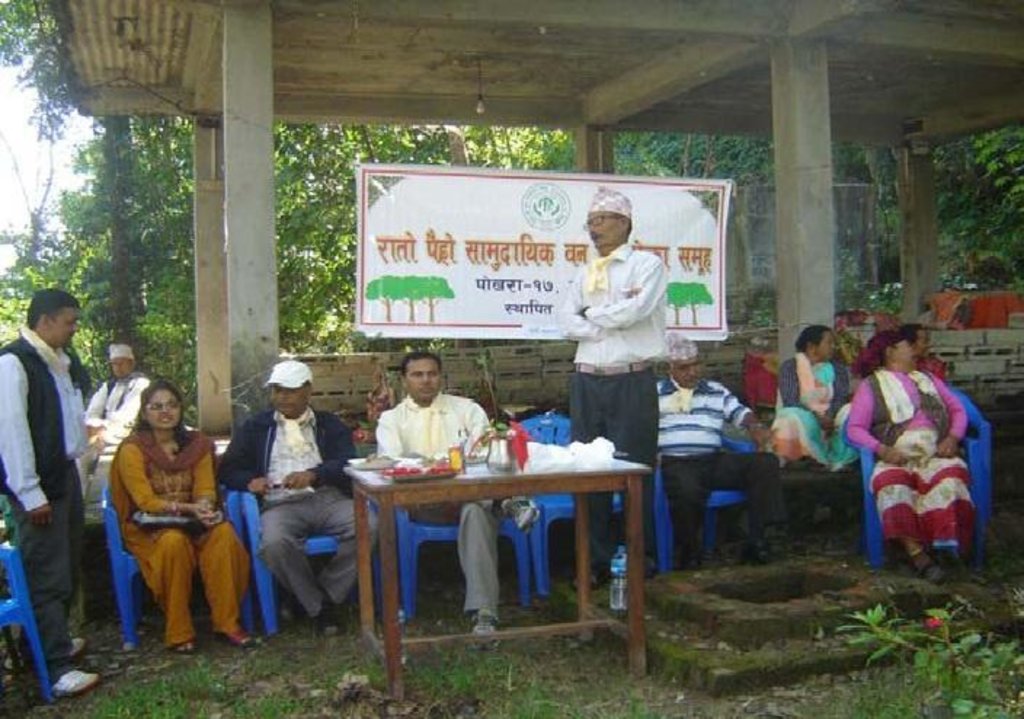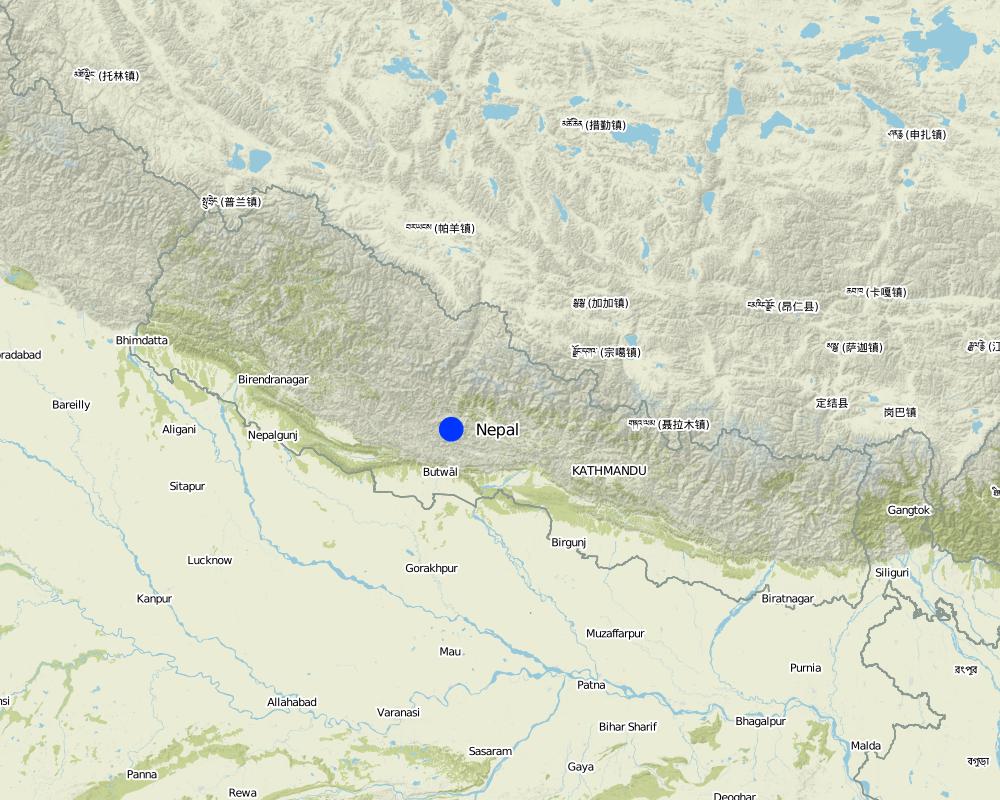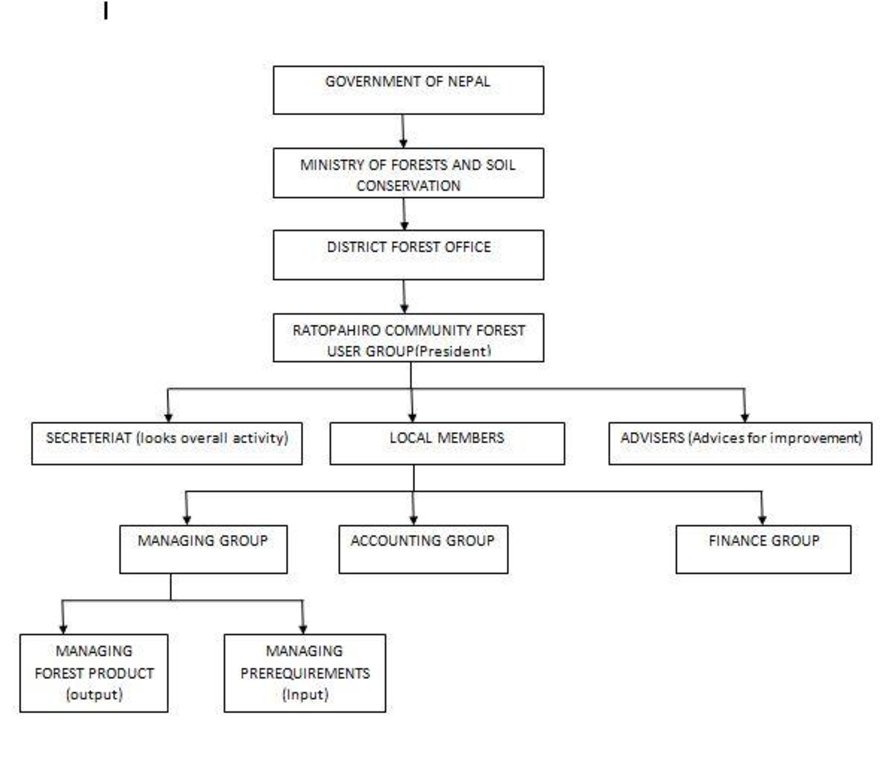Rato-Pahiro Community Forest [Nepal]
- Creation:
- Update:
- Compiler: Sabita Aryal
- Editor: –
- Reviewer: Fabian Ottiger
Rato-Pahiro community Forest
approaches_2593 - Nepal
View sections
Expand all Collapse all1. General information
1.2 Contact details of resource persons and institutions involved in the assessment and documentation of the Approach
SLM specialist:
Baral Madhav
District forest office
Nepal
SLM specialist:
Mesanayo Manish
Panauti-5,Kavre
Nepal
SLM specialist:
Subedi Sujata
Pokhara-7,Masbar
Nepal
SLM specialist:
Neupane Prabha
janagal-8,Kavre
Nepal
Name of the institution(s) which facilitated the documentation/ evaluation of the Approach (if relevant)
Kathmandu University (KU) - Nepal1.3 Conditions regarding the use of data documented through WOCAT
When were the data compiled (in the field)?
12/02/2012
The compiler and key resource person(s) accept the conditions regarding the use of data documented through WOCAT:
Ja
2. Description of the SLM Approach
2.1 Short description of the Approach
It is a particular land conservation activity by participatory approach forest protection and management,a project for sustainable forest use.
2.2 Detailed description of the Approach
Detailed description of the Approach:
Aims / objectives: To Integrate conservation and livelihoods goals.
To legally empower local communities to take control of forest resources and develop local level institutions to organize sustainable use of forest resources.
To protect biodiversity.
Methods: By increasing people's participation in afforestation programs.
Sustainable extraction of raw materials.
Regular supervision
Planting the economically high priced or demanded plant species.
Stages of implementation: Firstly DISTRICT FOREST OFFICE, KUDAHAR planted trees and it was later handed to local people.They started afforestation on the yearly basis since 2052 B.S.Now it is under the supervision of community only.
Role of stakeholders: They are the main organizers for successful and sustainable management of forest.
They collect the fund for forest maintenance.
They frequently study the condition of forest.
Other important information: It contains a lot of herbal plants but due to lack of experts and other technical resource,they are not being identified and valuable species have been destroyed as well.
2.3 Photos of the Approach
2.5 Country/ region/ locations where the Approach has been applied
Country:
Nepal
Region/ State/ Province:
Western Development Region
Further specification of location:
Kaski,Seti Bank Area
Map
×2.6 Dates of initiation and termination of the Approach
Indicate year of initiation:
2052
2.7 Type of Approach
- District Forest Office ,Kudahar
2.8 Main aims/ objectives of the Approach
The Approach focused mainly on SLM with other activities (Forest products such as tree and grass fodder, fuel wood and timber,making handicrafts, Supply of raw materials,Major products(Economic))
Protect the forest resource to some extent or ensure security of the houses around as the forest mostly covers the sloopy lands.Protect soil from erosion thus have a secure ,fresh,green environment.
The SLM Approach addressed the following problems: Low technical knowledge
Robbery of the forest products
Are not aware about the community forest approach
No proper supervision of the forest
2.9 Conditions enabling or hindering implementation of the Technology/ Technologies applied under the Approach
social/ cultural/ religious norms and values
- hindering
Problem of robbery,theft of forest property and selling illegally.
Treatment through the SLM Approach: Advisory groups and local members went for frequent check,knowledge to local people.
availability/ access to financial resources and services
- hindering
People from low class family cannot afford annual fee for the renewal or membership card.
Treatment through the SLM Approach: Special discount for the people with low quality of life.
institutional setting
- hindering
Before it was own by Area Forest Office.
Treatment through the SLM Approach: Collaboration with the locals and turning into community forest.
legal framework (land tenure, land and water use rights)
- hindering
Land was unusable ,difficult to access.
Treatment through the SLM Approach: Now turned as common property useful to all.
The existing land ownership, land use rights / water rights hindered a little the approach implementation At the beginning people didn't know about this approach but as it progressed they gave land rights for their own good.
knowledge about SLM, access to technical support
- hindering
Knowledge
Treatment through the SLM Approach: Experience and common sense
workload, availability of manpower
- hindering
Low mass involvement ,male members went to office
Treatment through the SLM Approach: Female members entered for forest conservation
other
- hindering
Unavailability of fodders,forest products
Treatment through the SLM Approach: Division and shared turn by turn within the forest capacity.
3. Participation and roles of stakeholders involved
3.1 Stakeholders involved in the Approach and their roles
- local land users/ local communities
Both male and female are involved. But no. of female is large,age group from 22 and above and below 60,people from all ethnic group are involved. Women are more active. They are idle at home ,male members go to office. There is a system of two quotas(seats) place for socially backward group.
- community-based organizations
Member of community forest
- local government
District Forest Office
- national government (planners, decision-makers)
Head Office Forest Department
3.2 Involvement of local land users/ local communities in the different phases of the Approach
| Involvement of local land users/ local communities | Specify who was involved and describe activities | |
|---|---|---|
| initiation/ motivation | interactive | This was done by DFO first and by the community forest mem bers. |
| planning | interactive | All carried out by the CFUG members for the betterment of CF. |
| implementation | self-mobilization | By the CF members like making rules and implementing. |
| monitoring/ evaluation | self-mobilization | Local people monitor timely. They.They keep the record of used materials and account. |
| Research | none | None |
3.3 Flow chart (if available)
Description:
This shows the relational chart of managing committee with some functions.
Author:
Prabha Neupane (Banepa)
3.4 Decision-making on the selection of SLM Technology/ Technologies
Were decisions on the selection of the Technology(ies) made:
- District Forest Office
Explain:
Initially under District Forest Office but later after turning into community forest all decision regarding it are taken under land users interest.
Decisions on the method of implementing the SLM Technology were made by District Forest Office. Both DFO and land users initiate it but major methods are implemented by the land users only.
4. Technical support, capacity building, and knowledge management
4.1 Capacity building/ training
Was training provided to land users/ other stakeholders?
Ja
Specify who was trained:
- land users
If relevant, specify gender, age, status, ethnicity, etc.
Both male and female between age( 22-60),every ethnic group and from the all standards.
Form of training:
- public meetings
Subjects covered:
Awareness on conservation of the land ,nursery plants,etc.
4.2 Advisory service
Do land users have access to an advisory service?
Ja
Specify whether advisory service is provided:
- at permanent centres
Describe/ comments:
Name of method used for advisory service: Public meeting; Key elements: Held on the regular basis, inform forest condition and give options for improving., Help to choose the best methods.; Need to have the experts and learned personals.
Advisory service is quite adequate to ensure the continuation of land conservation activities; 60-70% works are done under the supervision of the advisory groups.Some deny to take the advice.
4.3 Institution strengthening (organizational development)
Have institutions been established or strengthened through the Approach?
- yes, a little
Specify the level(s) at which institutions have been strengthened or established:
- local
Give further details:
The raw materials for making handicrafts like roots, branch of old trees were provided.
4.4 Monitoring and evaluation
Is monitoring and evaluation part of the Approach?
Ja
Comments:
bio-physical aspects were ad hoc monitored by land users through observations; indicators: runoff,erosion
socio-cultural aspects were regular monitored by land users through observations; indicators: age, status,health
economic / production aspects were regular monitored by land users through measurements; indicators: yield,income
no. of land users involved aspects were regular monitored by land users through measurements; indicators: local people
management of Approach aspects were regular monitored by land users through observations; indicators: allocation of activities
There were few changes in the Approach as a result of monitoring and evaluation: Plantation of value adding plants such as bamboo.
coffee plantation is in testing phase.
Economically viable plants are given preference.
There were several changes in the Technology as a result of monitoring and evaluation: Less valued are replaced by the other plants.
5. Financing and external material support
5.1 Annual budget for the SLM component of the Approach
If precise annual budget is not known, indicate range:
- 10,000-100,000
Comments (e.g. main sources of funding/ major donors):
Approach costs were met by the following donors: local community / land user(s) (All handled by the members of the CF.): 100.0%; other (Self)
5.2 Financial/ material support provided to land users
Did land users receive financial/ material support for implementing the Technology/ Technologies?
Ja
If yes, specify type(s) of support, conditions, and provider(s):
The raw materials for making handicrafts like roots, branch of old trees were provided.
5.3 Subsidies for specific inputs (including labour)
- none
If labour by land users was a substantial input, was it:
- voluntary
Comments:
Local members were self mobilized.
5.4 Credit
Was credit provided under the Approach for SLM activities?
Nee
6. Impact analysis and concluding statements
6.1 Impacts of the Approach
Did the Approach help land users to implement and maintain SLM Technologies?
- No
- Yes, little
- Yes, moderately
- Yes, greatly
The erosion is totally stopped by conserving the land and thus secured.
Did the Approach empower socially and economically disadvantaged groups?
- No
- Yes, little
- Yes, moderately
- Yes, greatly
Females were involved and participation of people from all ethnic groups.
Did the Approach improve issues of land tenure/ user rights that hindered implementation of SLM Technologies?
- No
- Yes, little
- Yes, moderately
- Yes, greatly
Government and CFUG help to reduce the problem by giving rights to local people. The problem is likely to be overcome in the near future.
Did other land users / projects adopt the Approach?
- No
- Yes, little
- Yes, moderately
- Yes, greatly
In the group overall.
Did the Approach lead to improved livelihoods / human well-being?
- No
- Yes, little
- Yes, moderately
- Yes, greatly
Provided fodders for animals,fuels for the people,selling the goods,handicraft making improved economic conditions of people.
Did the Approach help to alleviate poverty?
- No
- Yes, little
- Yes, moderately
- Yes, greatly
By selling the bamboo,firewoods. Handicrafts are sold in international markets hence are high priced.
6.2 Main motivation of land users to implement SLM
- increased production
bamboo,useful plants
- increased profit(ability), improved cost-benefit-ratio
selling the products
- environmental consciousness
Had sound, healthy and fresh environment
- well-being and livelihoods improvement
Along with natural and healthy environment people benifited economically from the forest
6.3 Sustainability of Approach activities
Can the land users sustain what has been implemented through the Approach (without external support)?
- yes
If yes, describe how:
People are independent and had not received any funds from national or international agency. It's been almost 20 years that they are handling the forest on their own so they definitely can continue the approach in a sustainable way.
6.4 Strengths/ advantages of the Approach
| Strengths/ advantages/ opportunities in the land user’s view |
|---|
| Forests are local resources for household activities (How to sustain/ enhance this strength: Utilization and conservation in sustainable manner.) |
| Strengths/ advantages/ opportunities in the compiler’s or other key resource person’s view |
|---|
|
The living standard is improved. Employment to the people. (How to sustain/ enhance this strength: Need to be more conscious while cutting the trees and grasses. Afforestation should be highly prioritized.) |
6.5 Weaknesses/ disadvantages of the Approach and ways of overcoming them
| Weaknesses/ disadvantages/ risks in the land user’s view | How can they be overcome? |
|---|---|
|
No proper improvement Low technical manpower Individualistic thoughts |
Need to have the regular meetings. Take as common property. Training and awareness raising programs. |
| Weaknesses/ disadvantages/ risks in the compiler’s or other key resource person’s view | How can they be overcome? |
|---|---|
|
No technical manpower. Low plant breeds. No doners |
Regular monitoring. Need to have the improved plants for more production. Technical help from experts. |
7. References and links
7.1 Methods/ sources of information
- field visits, field surveys
- interviews with land users
Links and modules
Expand all Collapse allLinks
No links
Modules
No modules


